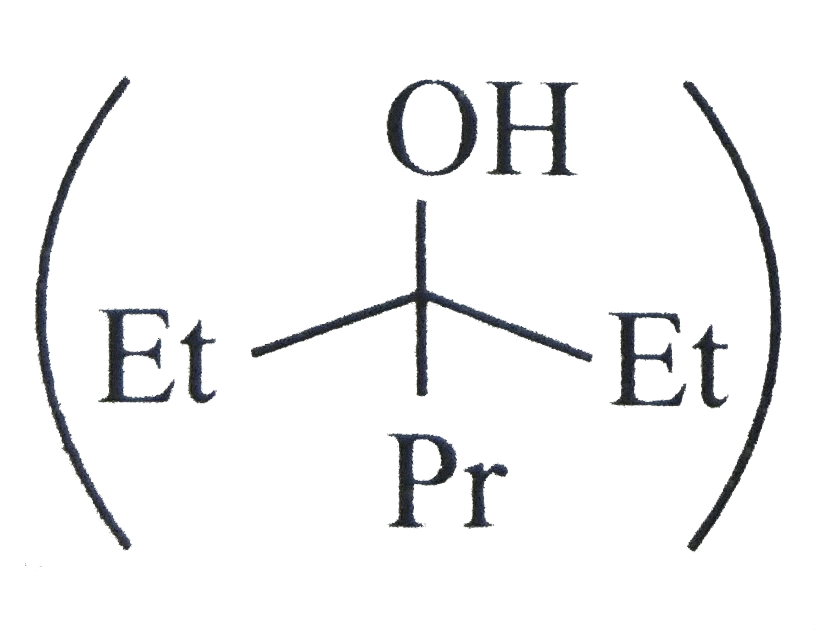Methyl bromide reacts with AgF to give methyl fluoride and silver bromide. This reaction is called
Fitting reaction
Swart reaction
Wurtz reaction
Finkelstein reaction
The correct Answer is:B
To solve the question regarding the reaction of methyl bromide with AgF to yield methyl fluoride and silver bromide, we will analyze the reaction step by step.
1. Identify the Reaction: The reaction involves methyl bromide (CH3Br) reacting with silver fluoride (AgF) to produce methyl fluoride (CH3F) and silver bromide (AgBr). The balanced chemical equation for this reaction is:
CH3Br+AgF→CH3F+AgBr
2. Classify the Reaction: This type of reaction is characterized by the exchange of halogens. In this case, bromine from methyl bromide is replaced by fluorine from silver fluoride.
3. Determine the Type of Reaction: The reaction can be classified as a halogen exchange reaction, which is commonly known as a Schwartz reaction. This reaction is specifically used for the conversion of alkyl bromides to alkyl fluorides using silver fluoride.
4. Eliminate Other Options:
- Wittig Reaction: This involves the formation of alkenes from aldehydes or ketones and phosphonium ylides, which is not applicable here.
- Wurtz Reaction: This involves the coupling of alkyl halides in the presence of sodium to form alkanes, which does not describe the given reaction.
- Finkelstein Reaction: This involves the exchange of halogens, typically between iodides and other halides, but it specifically involves sodium iodide, not silver fluoride.
5. Conclusion: Based on the analysis, the reaction of methyl bromide with silver fluoride to produce methyl fluoride and silver bromide is classified as a Schwartz reaction.
Final Answer:
The reaction is called the Schwartz reaction.
CH3Br+AgF→CH3F+AgBr
- Wittig Reaction: This involves the formation of alkenes from aldehydes or ketones and phosphonium ylides, which is not applicable here.
- Wurtz Reaction: This involves the coupling of alkyl halides in the presence of sodium to form alkanes, which does not describe the given reaction.
- Finkelstein Reaction: This involves the exchange of halogens, typically between iodides and other halides, but it specifically involves sodium iodide, not silver fluoride.
The reaction is called the Schwartz reaction.
Topper's Solved these Questions
- HALOALKANES AND HALOARENESBOOK - NCERT FINGERTPS ENGLISHCHAPTER - HALOALKANES AND HALOARENESEXERCISE - Physical properties
7 Videos
- HALOALKANES AND HALOARENESBOOK - NCERT FINGERTPS ENGLISHCHAPTER - HALOALKANES AND HALOARENESEXERCISE - Chemical reactions
68 Videos
- HALOALKANES AND HALOARENESBOOK - NCERT FINGERTPS ENGLISHCHAPTER - HALOALKANES AND HALOARENESEXERCISE - Nomenclature
6 Videos
- GENERAL PRINCIPLES AND PROCESSES OF ISOLATION OF ELEMENTSBOOK - NCERT FINGERTPS ENGLISHCHAPTER - GENERAL PRINCIPLES AND PROCESSES OF ISOLATION OF ELEMENTSEXERCISE - Assertion And Reason
15 Videos
- POLYMERS BOOK - NCERT FINGERTPS ENGLISHCHAPTER - POLYMERS EXERCISE - NCERT Exemplar
9 Videos
Similar Questions
Knowledge Check
Phenyl methyl ether (on anisole) reacts with HI to give phenol and methyl iodide and not iodobenzene and methyl alcohol. Justify .
AI− ion prefers to combie with the smaller group in order to minimise steric hindrance group in order to minimise steric hindranceBI− ion is not ractive towards benzneCphenol is formed as a result of hydrolyis of iodobenzeneDmehtyl alcohol fromed durin reaction racts wit I− to from methyl iodile .
When methyl bromide is heated with Zn it gives:
View SolutionPhenyl magnesium bromide reacts with methanol to give :-
View SolutionMethyl ester reacts with EtMgBr to give 3∘ alcohol
 The ester is :
The ester is :
View Solutionn-propyl bromide reacts with aqueous KOH to form:-
View SolutionPhenyl methyl ether reacts with HI to give phenol and methyl iodide and not iodobenzene and methyl alcohol. Why?
View SolutionMethyl amine on reaction with Hinsberg reagent gives :
View SolutionWhat happen when ethyl bromide reacts with AgCN.
View Solution
